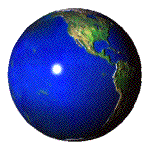 |
Terrestrial and extraterrestrial
volcanism:
|
|
 |
Large Igneous Provinces |
|
or LIPs are voluminous emplacements of predominantly mafic
extrusive and intrusive rock whose origins lie in processes other than 'normal' seafloor
spreading. LIPs include continental flood basalts and associated
intrusive rocks, volcanic passive margins, oceanic plateaus,
submarine ridges, seamount groups, and ocean basin flood basalts. Click on
this map of LIPs, shown below, to read about the research on LIPs.
|
 |
Notable LIPs on Land
The
most notable of continental flood basalts and flood basalt provinces are:
 |
Columbia
River Basalts (~15 Ma), |
 |
Ethiopian
Traps (~38 Na), |
 |
Deccan Traps
(~65 Ma), |
 |
Parana/Serra Geral
lavas (~135 Ma), |
 |
Karoo/Stromberg, Patagonian
and Ferrar lavas (~180 Ma), |
 |
Siberian
Traps (~250 Ma), and |
 |
Keweenawan Lavas
(~1,250 Ma).
|
|
|
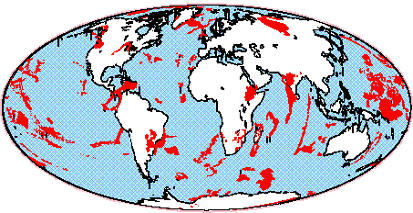 |
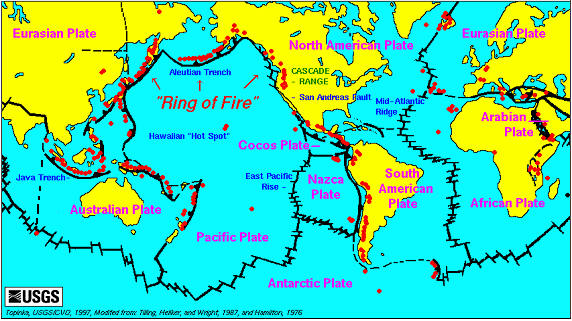
Explore Volcano World at the URL:
http://volcano.und.nodak.edu/vw.html. Also available on-line,at
http://adsbit.harvard.edu/books/bvtp/toc.html is
the treatise: Basaltic Volcanism on the
Terrestrial Planets. For extra-terrestrial volcanism, try the URL:
http://pubs.usgs.gov/gip/volc/extraterrestrial.html |
 |
Other Kinds of Volcanism:
 |
Spreading Submarine Ridges:
Spreading submarine ridges and rises (e.g., Reykjanes/ Mid-Atlantic Ridge,
East Pacific Rise, hydrothermal vents) and associated volcanic islands
(e.g., Iceland).
|
 |
Volcanism at the Subduction Zones
Convergent plate margins have volcanism towards the edge of the plate
that is being subducted (e.g., Cascade Ranges and the Pacific “Ring of
Fire”)..
|
 |
'Hot
Spots' and Aseismic Ridges:
Intra-plate or “hot-spot” volcanism (e.g., Hawaii-Emperor Seamounts,
Yellowstone-Snake River volcanics)
|
|
|
| |
|
|
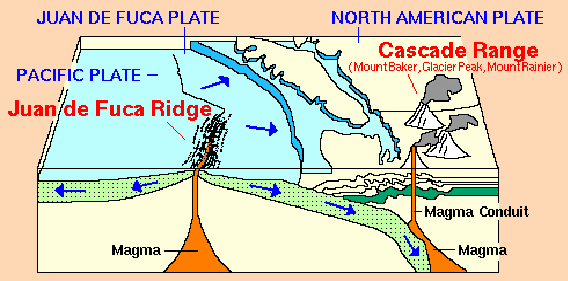 |
The sketch alongside, taken from the URL:
http://vulcan.wr.usgs.gov/Glossary/Plate
Tectonics/Maps/map_juan_de_fuca_subduction.html explains the entire
cycle of volcanism from Juan de Fuca Ridge to Juan de Fuca subduction (i.e.,
the Filled Trench) and
the Cascades. |
| |
|
|
|
 |
Volcanic
materials/products and rock classification:
 |
Volcanic
Rocks:
Increasing
order of silica (SiO2) content,
from silica-rich rhyolite at one end and the more common basalt at the
other, with the compositionally intermediate andesite
denoting crustal contamination of the
magma on its passage through the
crust.
|
|
Why
andesites on Mars, then?
|
|
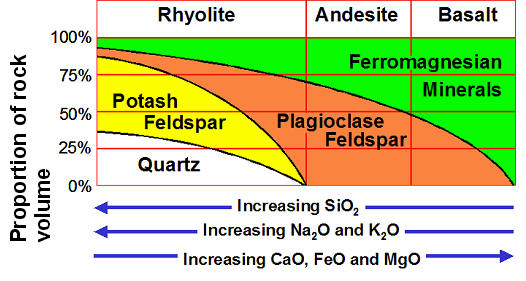 |
| |
|
|
 |
Other
products :
 |
Cinder cones/ Pyroclastics (Ash, Cinders, Blocks/Bombs, Lahars)
|
 |
Gases and Gas Clouds: Nuees Ardentes, Toxics, Climate Change
|
 |
Other materials: Pyroclasts, Volcanic Breccia
|
|
|
|
 |
Textures of Volcanic Rocks:
 |
Glassy (Obsidian), |
 |
Vesicular (Scoria, Pumice), |
 |
Aphanitic (Andesite, Basalt,
Rhyolite), |
 |
Porphyritic (Andesite Porphyry, Basalt Porphyry, and Rhyolite Porphyry). |
|
|
|
Visit the USGS volcanoe sites, starting
with
http://volcanoes.usgs.gov/
and its links
Also try the site:
http://interactive2.usgs.gov/learningweb/explorer/topic_rocks_igneous.htm |
|
|
| |
|
|
 | Volcanic Precursors and/or
Predictors?
 | Seismicity
(Harmonic Tremors?) |
 | Bulging or
Uptilting? |
 |
Exotic
Gas Emanations? |
|
|
Volcanism and Climate
Try
http://www.etl.noaa.gov/about/review/aq/post
for a comparison of the
climate effects of Mt. Pinatubo and El Chichon events. |
|
 |
Is
Volcanism Predictable?
|
|
American Geophysical
Union has an interesting discussion of terrestrial degassing at the URL:
http://www.agu.org/sci_soc/eosvarekamp.html.
Also try the URL:
http://unr.edu/homepage/fbiondi/BiondiFessenden1999E.pdf |
|
 | Try the following links for interesting presentations on the rock
cycle shown alongside:
|
|
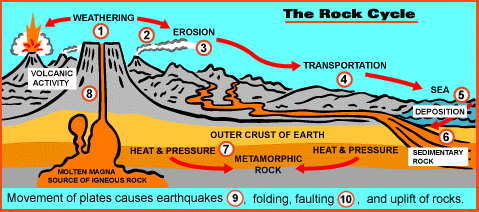 |
|
